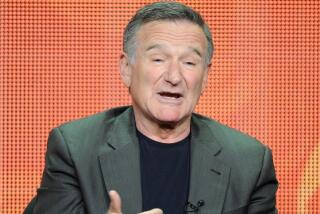How Robin Williams became ‘Aladdin’s’ Genie
- Share via
In 1991, directors John Clements and Ron Musker gave Disney animator Eric Goldberg an unusual assignment: listen to Robin Williams’ stand-up albums and draw the comic, as a genie.
Clements and Musker were making “Aladdin,” the musical fantasy that would go on to become the highest grossing film of 1992, win two Oscars and help cement the artistic and commercial renaissance then underway at Disney Animation.
But at the time, the directors were simply trying to sell Disney executives and Williams himself on the idea of casting the actor as the voice of their shape-shifting sidekick.
For a test, Goldberg animated a routine in which Williams riffed that, tonight he’d like to talk about schizophrenia. In another voice, Williams snapped that, no he would not. Goldberg drew the genie -- a big blue strongman with a tiny topknot and Williams’ face -- growing a second head so he could argue with himself.
“Robin totally got what kind of potential animation had in utilizing his talents,” Goldberg told The Times in an interview Tuesday. “If you think back on a lot of animation voices over history, especially from 1930s and ‘40s, many were radio actors. They could express so much with their voices... What Robin had in common with them is a set of vocal chords that were 100% elastic.”
Williams’ vocal performance would become central to the success of the movie, and, for many who saw it as children, his most defining role.
When news of the actor’s death by apparent suicide broke on Monday, many on social media began sharing an image from the film of Genie hugging Aladdin with a tear in his eye.
With his myriad impressions, the comic lent the family film a sly sense of humor, often pushing the boundaries of what might appear in a Disney movie.
“Did I see Robin doing any improvisation? That would be like saying did you see the pope wearing his vestments?” said Goldberg, who became the supervising animator on the character. “He turned into a game show host, an evangelist. Out came all the celebs -- Arnold Schwarzenegger, John Wayne, George C. Scott. We took the stuff back to Burbank and went ... ‘Oh my God, this is gold... Will they let us put this in the picture?’”
Much to the animator’s surprise, he said, Disney did let them keep most of Williams’ improvised scenes. When the movie opened, the result was widespread critical praise for the character.
Reviewing the film in 1992, Times critic Kenneth Turan wrote of Williams’ Genie that, “animation has never had a human partner who so pushed it to its comic limits,” while the New York Times’ Janet Maslin called him a “dizzying, elastic miracle.”
“We could have just gotten somebody who was technically adept at impressions,” Goldberg said. “But the warmth that Robin brought was something we tried very hard to convey. Sidekicks carry the comedy, yes, but you also have to believe that they care about the main character. You have to believe their sincerity. Without that, you would have a technical exercise, but no heart.”
More to Read
Only good movies
Get the Indie Focus newsletter, Mark Olsen's weekly guide to the world of cinema.
You may occasionally receive promotional content from the Los Angeles Times.











